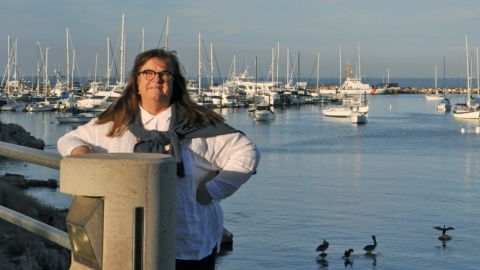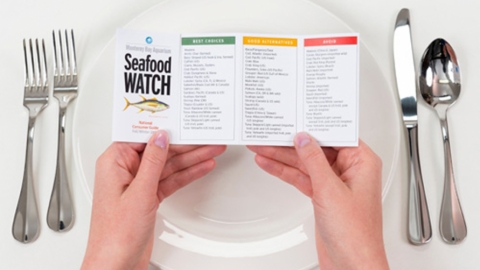Seafood Watch 2020: Making Sustainable Seafood Choices
20 Years Later, Monterey Bay Aquarium Continues to Fish for Ways to Help You Make Sustainable Seafood Choices.
Choosing seafood should be like choosing wine. “If someone simply said to you, ‘Here’s some wine,’ you’d have questions,” says Sheila Bowman, manager of Seafood Watch’s Culinary and Strategic Initiatives. You’d want to know the types of grape, where it was grown, etc. She wants seafood to be like that too. “If someone says, ‘Here’s some salmon,’ you should have questions.” Find out what species it is, where it came from, how it was caught.
Part of the challenge is knowing what to do with the answers. Line-caught, nets, dragging, farmed, wild—many people don’t yet have the vocabulary and understanding of what makes for a quality seafood product in terms of sustainability. That’s where Seafood Watch comes in.
Fishing for Solutions
Started as a part of the Monterey Bay Aquarium’s Fishing for Solutions exhibit in the late 1990s, Seafood Watch provides people with a list of sustainable seafoods to eat and others to avoid on their website, as well as a consumer guide and app. A pocket-sized consumer guide and list is printed twice a year with these helpful lists: Best Choices, Good Alternatives and Avoid. More than 60 million of these guides have been printed and are in circulation. For in-depth information on the go, there is the Seafood Watch app, which is updated once a month. From abalone to wreckfish, you can find out details of the “what and why” of the different recommendations. And it turns out, there’s a lot more than people might realize.
For example, for salmon there are six types—Atlantic, Chinook, chum, Coho, pink and sockeye. You also need to find out if it’s domestic or imported, and if it was farmed or wild. Let’s say you look at farmed Atlantic salmon, the first option on the list. If it’s raised in an indoor recirculating tank, it’s a Best Choice. Or if it’s by Norway’s Salten Aqua Group under the Nordic Blu brand, it’s on the Best Choice list. Other brands and locations may have more concerns, and they go into detail about why on the app and website.
Seafood Watch ® Consumer Guides
![]()
![]()
![]()
![]()
![]()
![]()
![]()
![]()
And that’s just the tip of the iceberg. Sheila explains a large, and largely unseen, part of their work: “Around 90% of North America’s seafood is imported, so to foster those recommendations we have people working in faraway places.”
The two big focus areas right now are shrimp and salmon. The biggest US source for shrimp is from Southeast Asia, and the biggest source for farmed salmon is Chile, so Seafood Watch has people out working with companies in these areas. “Getting things right there is a big win for everyone.”
Obviously people eat more than shrimp and salmon, but Seafood Watch can’t do everything. After all, they only have around 20 employees. Drawing a circle in the air with one hand, Sheila says, “We can take care of this area,” then drawing another circle next to it, “And others [sustainability-focused organizations] can take care of this area.” Divide and conquer to bring sustainable seafood to as many people as possible.
Best Choices Might Be Farmed Fish
It might surprise some people what sustainability looks like—it does involve farming seafood. There is often the idea that farmed fish is bad and wild is better. In some cases that’s true, but a quote from Paul Greenberg’s book Four Fish: The Future of the Last Wild Food sums up the dilemma, using salmon as an example: “It would be wonderful if all the salmon we eat could be wild. But as one marine ecologist said to me recently, to continue to eat large wild fish at the rate we’ve been eating them we would need ‘four or five oceans’ to support the current human population.”
Farmed fish has been vilified in the past, and in the cases of the most intensive, high-chemical, high-density farms, that’s fair. Sheila breaks down the reality around farmed fish: “That destructive model, which is a 20- to 30-year-old approach centered on salmon, is still out there. But so many of our Green list items are farmed.” (Being on the Green list means they’re well managed and caught or farmed in ways that cause little harm to habitats or other wildlife.)
And those mistakes of the past, she hopes will be avoided as aquaculture continues to grow. “We’ll see countries like India, which is emerging as a major shrimp source, and Mexico skip the environmental destruction phase and build based on the best practices of today.”
Widening the Net for 2020 and Beyond
![]()
Moving forward, Seafood Watch also wants to work on spreading awareness and communication about sustainable seafood. “As other groups take on seafood assessment roles, we’re going to step in to what we do best, which is communication.”
They’ll continue to update the app and have partner restaurants and businesses. Just a few examples from Silicon Valley include restaurants like Flea St. Café, Tacolicious and Pacific Catch, and markets like New Seasons Market and Whole Foods Markets, who have pledged to not sell anything from the Avoid list. But along with the partnerships, they want to do more to talk directly to the public with events and social media engagement. Giving people the knowledge of how to talk about seafood is giving them the tools for making better choices.
Making those better choices means taking longer with your menu to figure out not just what sounds like it will taste good, but what will do some good for the planet. “Ask the wait staff. If you want a cleaner fish, sustainable fish, the only way you’ll get it on the menus is if you ask them,” suggests Sheila. She’s also received calls from restaurants saying that a customer left a copy of the Seafood Watch consumer guide with their check, and the restaurant wants to know more about the program. It’s a low-effort way to use your voice for good, and it’s important to realize that small steps can help spur big change. The more consumers understand what the best choices are, the more likely businesses will provide those options.
Along with making a smart choice from a restaurant menu, it’s good to know what to get for your kitchen. “Around 80% of the seafood eaten in the country is not cooked by the consumer. A lot of people are afraid to cook it,” notes Shelia. If they do, out of habit and comfort it’s often the same species like salmon, shrimp and tuna. Seafood Watch is trying to help out there as well. On their website, there’s a section of chef-created recipes like Arctic Char with Potato-Morel Salad and Leek Vinaigrette and Spiced Catfish Tacos with Pickled Shallots and Chipotle Crema.
The ultimate ideal for choosing your seafood at home or in the restaurant would be both local and sustainable, but that may not always be possible. Remember: Only around 10% of the seafood consumed in the US is from the US. It could become easy to be overwhelmed trying to do the “right” thing all the time in terms of sustainability. For example, a fish from Chile may be a Best Choice, but it inherently racked up a lot of food miles, energy and climate impact for moving food from point A to point B. So it’s good in one respect but problematic in another.
How do you make smart choices? Don’t despair. Take those small steps to be aware of your choices and potential impacts, and don’t be afraid to ask questions about the fish or its source. Keep the Seafood Watch app or pocket guide handy, and be willing to try fish you know has been raised sustainably—whether wild or farmed.
And finally, always ask what’s seasonal and local on the menu or in your market. Our regional coastline, and the local fisheries of the Pacific, are not only the smartest choices, but as Seafood Watch will confirm, the best choices too.




